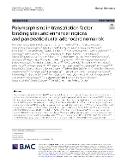Polymorphisms in transcription factor binding sites and enhancer regions and pancreatic ductal adenocarcinoma risk

Autor
Ünal, Pelin
Lu, Ye
Bueno-de-Mesquita, Bas
van Eijck, Casper H. J.
Talar-Wojnarowska, Renata
Szentesi, Andrea
Gazouli, Maria
Kreivenaite, Edita
Tavano, Francesca
Małecka-Wojciesko, Ewa
Erőss, Bálint
Bunduc, Stefania
Nóbrega Aoki, Mateus
Boggi, Ugo
Giaccherini, Matteo
Kondrackiene, Jurate
Chammas, Roger
Palmieri, Orazio
Theodoropoulos, George E.
Bijlsma, Maarten F.
Basso, Daniela
Mohelníková-Duchoňová, Beatrice
Izbicki, Jakob R
Kiudelis, Vytautas
Vanella, Giuseppe
Arcidiacono, Paolo Giorgio
Włodarczyk, Barbara
Hackert, Thilo
Schöttker, Ben
Uzunoglu, Faik G.
Bambi, Franco
Goetz, Mara
Brenner, Hermann
Perri, Francesco
Carrara, Silvia
Landi, Stefano
Hegyi, Péter
Dijk, Frederike
Maiello, Evaristo
Capretti, Giovanni
Testoni, Sabrina Gloria Giulia
Petrone, Maria Chiara
Stocker, Hannah
Ermini, Stefano
Archibugi, Livia
Gentiluomo, Manuel
Cavestro, Giulia Martina
Pezzilli, Raffaele
Di Franco, Gregorio
Milanetto, Anna Caterina
Sperti, Cosimo
Neoptolemos, John P.
Morelli, Luca
Pasquali, Claudio
Lawlor, Rita T
Bazzocchi, Francesca
Kupcinskas, Juozas
Capurso, Gabriele
Campa, Daniele
Canzian, Federico
Datum vydání
2024Publikováno v
Human GenomicsNakladatel / Místo vydání
Henry Stewart PublicationsRočník / Číslo vydání
18 (February)ISBN / ISSN
ISSN: 1473-9542ISBN / ISSN
eISSN: 1479-7364Informace o financování
UK//COOP
MSM//LX22NPO5102
Metadata
Zobrazit celý záznamTato publikace má vydavatelskou verzi s DOI 10.1186/s40246-024-00576-x
Abstrakt
Genome-wide association studies (GWAS) are a powerful tool for detecting variants associated with complex traits and can help risk stratification and prevention strategies against pancreatic ductal adenocarcinoma (PDAC). However, the strict significance threshold commonly used makes it likely that many true risk loci are missed. Functional annotation of GWAS polymorphisms is a proven strategy to identify additional risk loci. We aimed to investigate single-nucleotide polymorphisms (SNP) in regulatory regions [transcription factor binding sites (TFBSs) and enhancers] that could change the expression profile of multiple genes they act upon and thereby modify PDAC risk. We analyzed a total of 12,636 PDAC cases and 43,443 controls from PanScan/PanC4 and the East Asian GWAS (discovery populations), and the PANDoRA consortium (replication population). We identified four associations that reached study-wide statistical significance in the overall meta-analysis: rs2472632(A) (enhancer variant, OR 1.10, 95%CI 1.06,1.13, p = 5.5 x 10(-8)), rs17358295(G) (enhancer variant, OR 1.16, 95%CI 1.10,1.22, p = 6.1 x 10(-7)), rs2232079(T) (TFBS variant, OR 0.88, 95%CI 0.83,0.93, p = 6.4 x 10(-6)) and rs10025845(A) (TFBS variant, OR 1.88, 95%CI 1.50,1.12, p = 1.32 x 10(-5)). The SNP with the most significant association, rs2472632, is located in an enhancer predicted to target the coiled-coil domain containing 34 oncogene. Our results provide new insights into genetic risk factors for PDAC by a focused analysis of polymorphisms in regulatory regions and demonstrating the usefulness of functional prioritization to identify loci associated with PDAC risk.
Klíčová slova
Association study, Enhancer, Pancreatic cancer, Single nucleotide polymorphism, Transcription factor binding site
Trvalý odkaz
https://hdl.handle.net/20.500.14178/2684Licence
Licence pro užití plného textu výsledku: Creative Commons Uveďte původ 4.0 International







